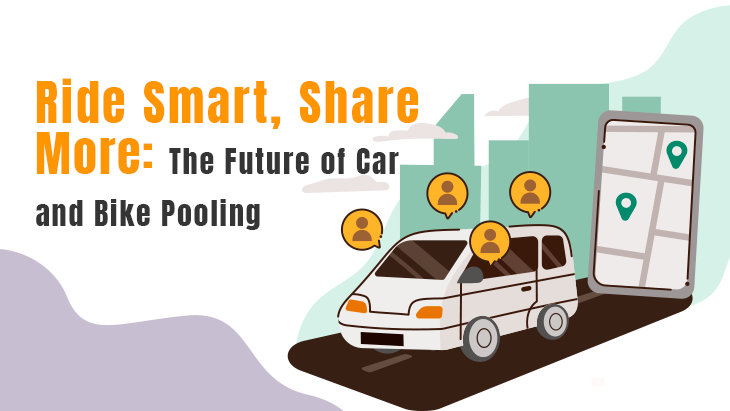Ride Smart, Share More: The Future of Car and Bike Pooling

Posted on: 17 October, 2024
The need for good transport solutions at a highly efficient level has been more pertinent given the core concerns over sustainability and community now than ever before. Simplifying Your Daily Commute. Urbanization on the rise, coupled with greater awareness over environmental concerns, is a basic ingredient for new innovative transport models. Of these models, car and bike pooling platforms stand out. They are remodeling our thought process about commutes by giving us a peek into some possible future a world where shared mobility becomes normal rather than the exception.
Rise of Shared Mobility
Car sharing is not a relatively new thing. Carpooling is a practice that, for years and decades, has been widely practiced by friends and colleagues. But then came the digital revolution and did something with this age-old practice by multiplying its possibility. With the advent of mobile applications and online platforms, car and bike pooling became more accessible and efficient.
Today and tomorrow's car and bike pooling platforms use technology to connect people in real time, thus optimizing routes and cutting on the cost of travel. Such innovations have captured the cities of the world and, to a large extent, have solved the problem of commuting in towns.
Why car and bike pooling?
1. Environmental Benefits
One of the very best utilizations and uses of car and bike pooling happens to be on the environmental side. With pooling rides, the number of cars driving on the highway is greatly reduced, which naturally means reduced carbon emissions and less fuel consumption. Bike pooling therefore complements the green city culture, as cycling is promoted as a practical alternative to driving.
2. Cost Savings
Through a car and bike, a pooling platform has the potential to save enormous sums of money for users. The splitting of fuel costs, parking costs, and maintenance benefits commuters with an affordable means to get to work or to other destinations. To the advocates of bike pooling, savings are reduced personal bike wear and tear together with less maintenance.
3. Social relationships
Sharing a ride enables community building by allowing someone to engage with others who use the service and share experiences and relationships with fellow travelers. This social element can make an otherwise very lonely and quite disengaged experience much more exciting.
4. Improved Traffic Congestion
Pooling also solves the inherent vehicular traffic congestion in cities. Reducing the number of cars on a road acts to mitigate this. Furthermore, as people pool themselves, cities could see reduced drudgery, leading to improved air quality and a more enjoyable travel experience.
Role of Technology in Pooling Platforms:
Advanced technology drives the success of car and bike pooling platforms. These are how the platforms utilize innovations for the betterment of users' experiences:
1. Buddy Apps
For most car and bike pooling applications, a beautiful application is merely descriptive. These applications make the search and booking of rides more convenient for the users. They can connect with people close to them, check possible matches, and thus arrange shared rides with just a few taps of their fingers.
2. Real-Time Data
Leverage real-time data, which subsequently would allow its users to know conditions of traffic, availability of rides, and even estimated time of arrival. This would suffice for a user to make an informed decision on commuting.
3. Safety Features
Shared transportation is also quite a safe affair. Many applications of car and bike pooling use security features such as rating users, background checks, and even GPS tracking. This ensures that a proper environment is created for both the user and the driver, thus building confidence in the system.
4. Incentives and Rewards
Most of these platforms encourage increasing user participation. Users are gifted with discount offers, loyalty programs, and referral bonuses, among others. These encourage not just user engagement but also popularize sharing cultures.
Future of Car and Bike Pooling
The more the population grows in cities, the greater the demand for solutions to the need for transportation. Some trends that clearly show the future of car and bike pooling are as follows:
1. Interconnectedness with Public Transport Car and bike pooling sites are now, however, slowly integrating into the public transport system in most cities. Integration harmoniously links other modes of transport so that commuters can easily shift from one mode of transport to another and put up a holistic approach to urban mobility.
2. Electric and autonomous vehicles
This further also brings in exciting opportunities for car pooling with the growth of electric and self-driving cars. Given the zero-emission potential, EVs are a great fit for shared transport. Next, there will be a future when poolers are controlled by autonomous shuttles as the self-driving technologies advance.
3. Community-Focused Initiatives
Future car and bike pooling platforms will keep engaging people towards the community. Local organizations will join hands with the stations to enable their activities that boost people to move more and more sustainably while facilitating local businesses.
4. More Personalization
The car and bike pooling platforms are going to be more personalized in the coming days, with technological advancements in them. Applying specific algorithms in machine learning, the preference of a user is going to be determined, thereby ride recommendations being developed accordingly to enhance the experience of users.
Conclusion
Trip tie Platform for car and bike pooling will definitely change the whole transportation paradigm as we have known it. Shared mobility, which, with embracing it, will give us a chance for commutes that will be more sustainable, cost-efficient, and community-oriented. Technology has come of age in itself, and if they continue to be the way they have been, the future of car and bike pooling would certainly be bright and promising in the tackling of some of our nagging urban issues.
So the next time you sit there working out your commuting arrangements, consider joining this movement. Ride smarter, share more, and contribute to a greener and more connected future.


